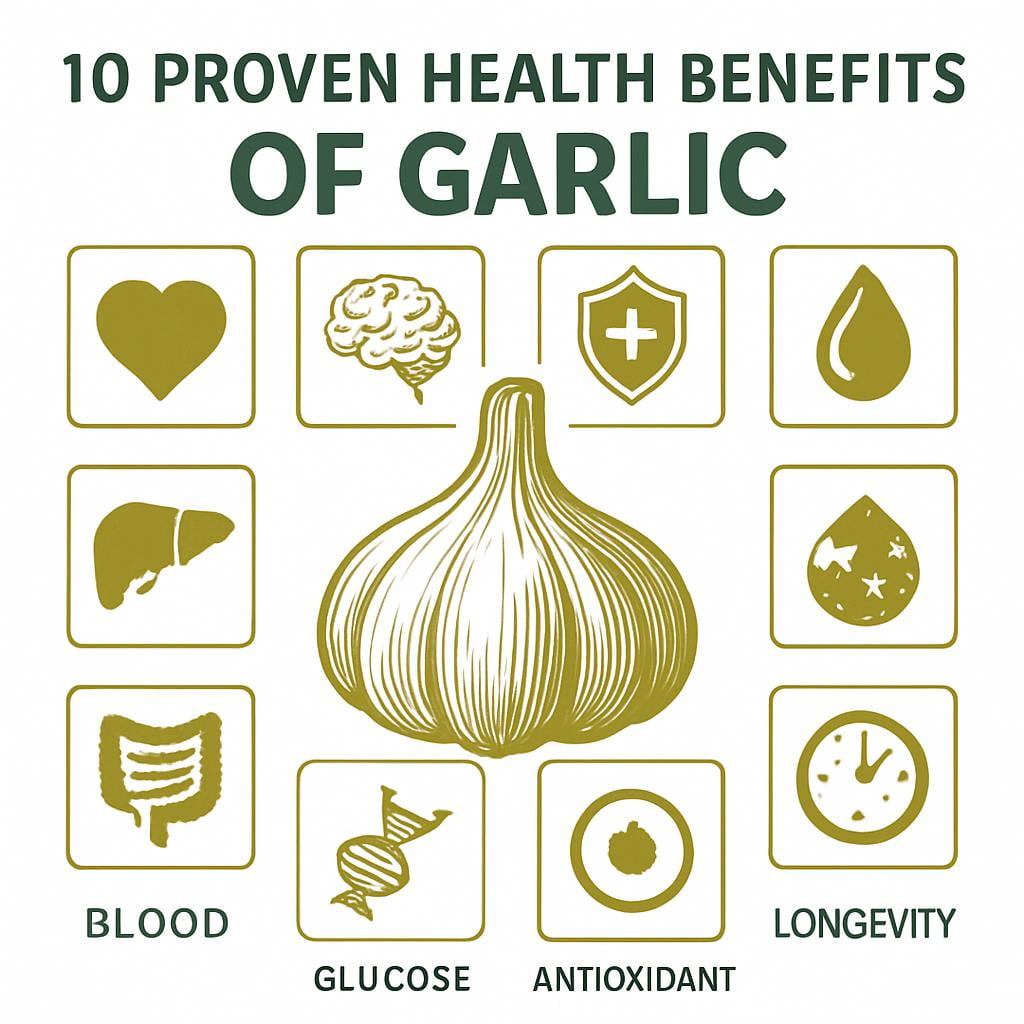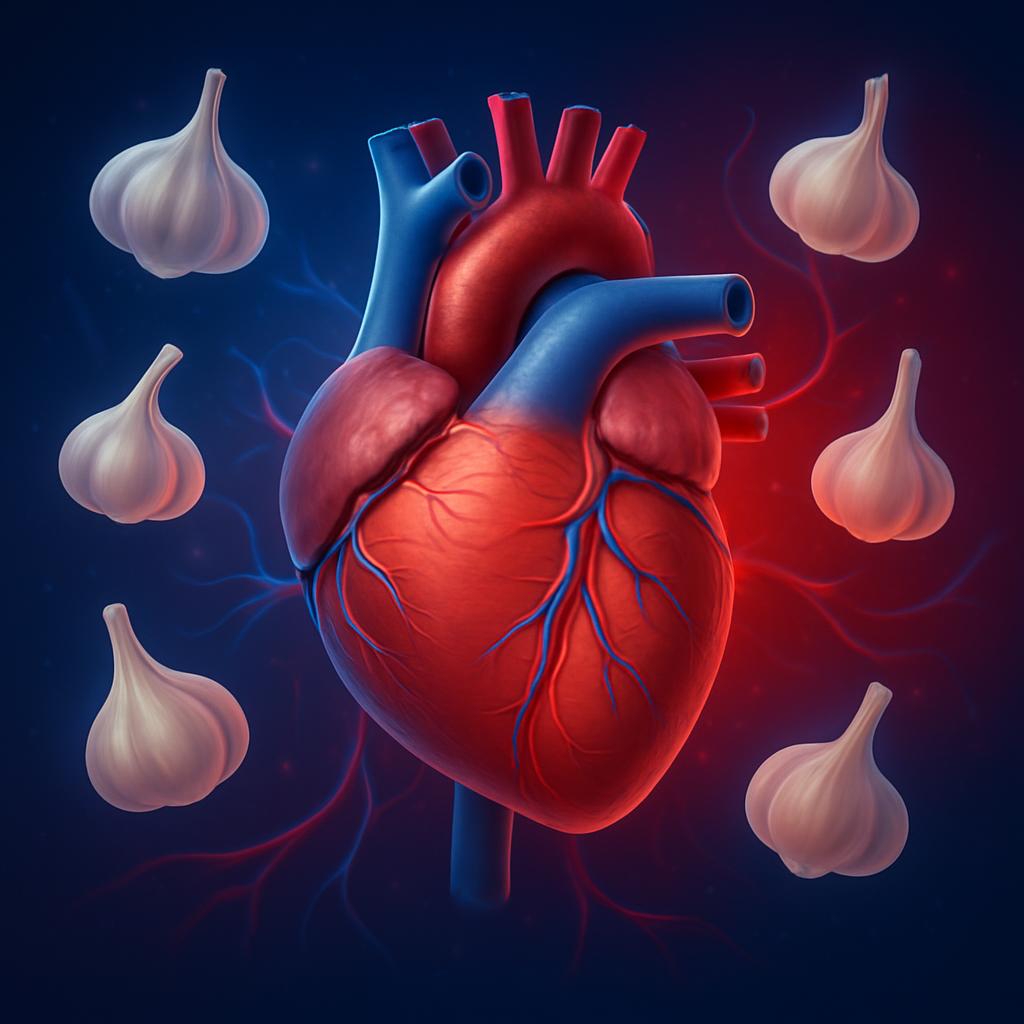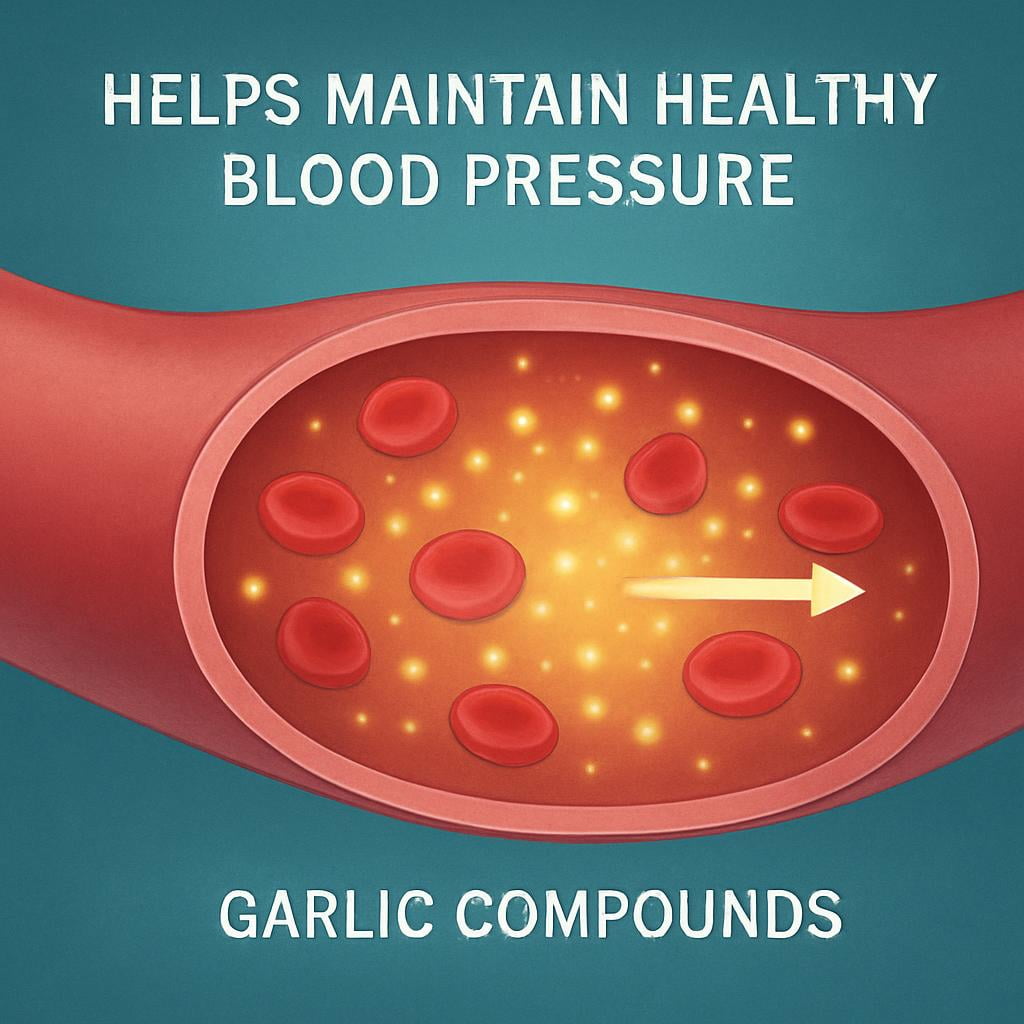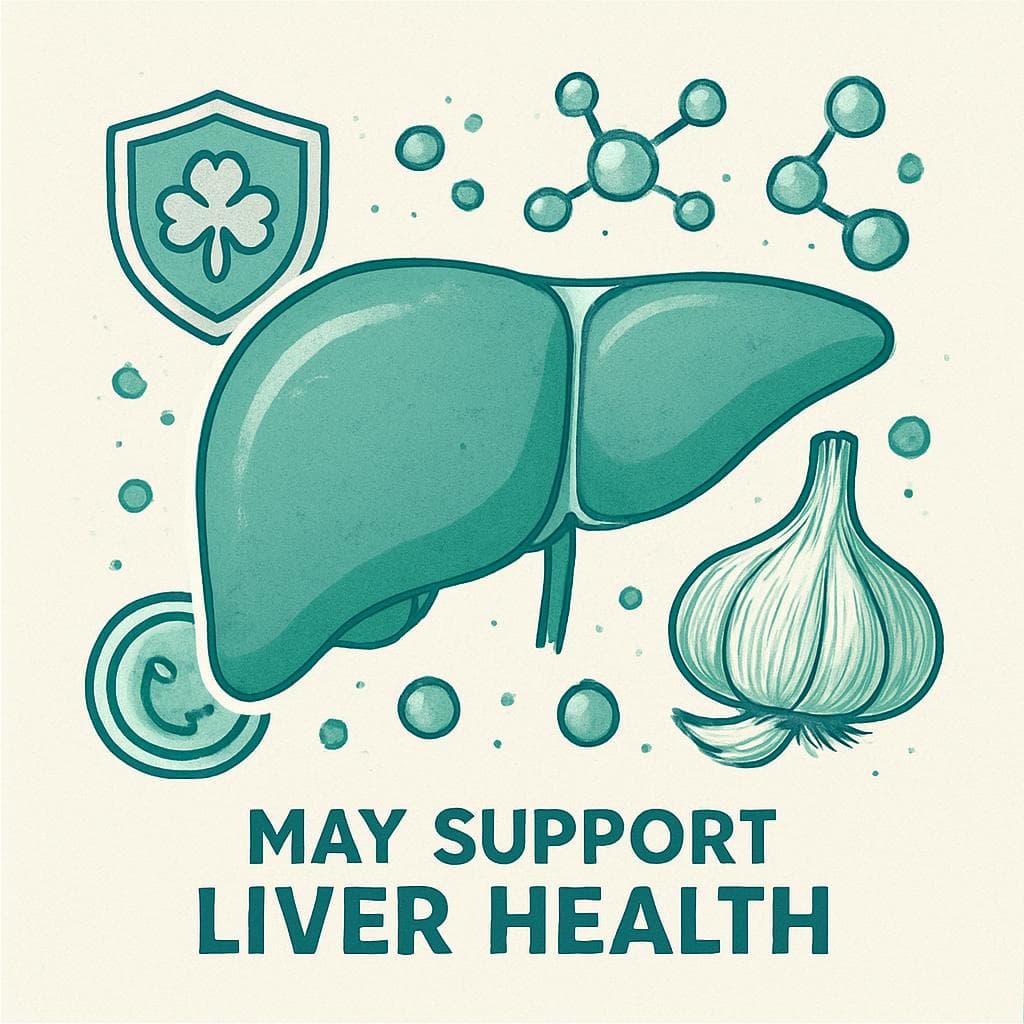Garlic may help support heart health, improve cholesterol levels, boost immunity, and offer antioxidant protection — all backed by scientific research.
Understanding the health benefits of garlic is valuable for anyone focused on nutrition, cardiovascular wellness, or preventive health. Rich in bioactive sulfur compounds like allicin, garlic has been studied extensively for its effects on blood pressure, cholesterol, immune response, and oxidative stress.

Below, we explore ten science-backed benefits of garlic, its nutritional profile, and important safety information to help you include it wisely in your diet.
What Is Garlic? (Overview and Nutrition Profile)
Garlic (Allium sativum) is a bulbous plant belonging to the Amaryllidaceae family, closely related to onions, leeks, and shallots. It has been used for centuries as both a culinary ingredient and a natural health-supporting food. Native to Central and South Asia, garlic is valued for its distinct flavor and its concentration of bioactive sulfur compounds, such as allicin, ajoene, and diallyl sulfides, which are responsible for many of its studied benefits.
When garlic is crushed, chopped, or chewed, the enzyme alliinase converts alliin into allicin — a short-lived but powerful compound with antioxidant and antimicrobial properties. This reaction underlies much of garlic’s biological activity and contributes to its role in supporting cardiovascular, metabolic, and immune function.
Garlic is available in several forms:
- Fresh cloves (raw or cooked)
- Aged garlic extract (AGE) – odorless, stabilized, and rich in S-allyl cysteine
- Garlic oil or powder – used in cooking or standardized supplements
According to the National Institutes of Health (NIH) – Garlic Fact Sheet, garlic is widely consumed worldwide for both culinary enjoyment and potential health-supporting properties.

Nutritional Composition of Garlic (USDA Data)
Garlic is a low-calorie, nutrient-dense food that contains essential vitamins, minerals, and antioxidants. According to the U.S. Department of Agriculture (USDA) FoodData Central, 2024, 100 grams of raw garlic provides:
| Nutrient | Amount (per 100 g) | % Daily Value (DV) |
|---|---|---|
| Calories | 149 kcal | — |
| Carbohydrates | 33.1 g | 11% |
| Protein | 6.36 g | 13% |
| Dietary Fiber | 2.1 g | 7% |
| Total Fat | 0.5 g | <1% |
| Vitamin C | 31.2 mg | 34% |
| Vitamin B6 | 1.24 mg | 92% |
| Manganese | 1.7 mg | 76% |
| Selenium | 14.2 µg | 26% |
| Calcium | 181 mg | 14% |
| Iron | 1.7 mg | 9% |
Garlic also provides small amounts of zinc, potassium, magnesium, and various flavonoids and saponins that may contribute to its antioxidant potential.
Key Takeaways
- Garlic is rich in sulfur-containing compounds that may support cardiovascular, immune, and metabolic health.
- It provides meaningful amounts of vitamin B6, vitamin C, manganese, and selenium, nutrients involved in energy metabolism and antioxidant defense.
- Preparation matters — crushing or chopping garlic and allowing it to rest for 10–15 minutes helps maximize allicin formation, enhancing its potential benefits.
10 Proven Health Benefits of Garlic (Backed by Science)
Garlic is more than a flavorful kitchen staple — it’s a nutrient-dense food packed with sulfur compounds that have been widely researched for their potential health benefits. Modern studies suggest that regular garlic intake may support cardiovascular, metabolic, and immune health when incorporated into a balanced diet.
1. Supports Heart Health

Garlic may support cardiovascular wellness by promoting healthy blood flow and reducing oxidative stress in blood vessels. Its main bioactive compound, allicin, supports vascular elasticity and helps maintain optimal cholesterol balance.
A 2024 meta-analysis in Frontiers in Nutrition found that consistent garlic intake was associated with improved blood pressure and lipid profiles among adults with hypertension. These effects are linked to enhanced nitric oxide activity and antioxidant enzyme regulation, both of which contribute to vascular protection.
2. Helps Maintain Healthy Blood Pressure

Several controlled human trials have shown that garlic supplementation may help maintain healthy blood pressure levels, especially in individuals with mild hypertension. Garlic’s active compounds appear to relax blood vessel walls and improve endothelial function.
According to a 2021 review in Phytomedicine, garlic extracts lowered systolic blood pressure by about 8 mm Hg and diastolic by 5 mm Hg—results comparable to some mild antihypertensive medications when used under medical supervision. Regular inclusion of garlic in meals may therefore support long-term heart health.
3. May Improve Cholesterol Levels

Garlic can support balanced cholesterol by reducing total and LDL (“bad”) cholesterol while maintaining HDL (“good”) cholesterol. Its sulfur compounds may inhibit hepatic cholesterol synthesis and improve lipid metabolism.
A meta-analysis published in Nutrition Reviews (Oxford Academic) found that participants consuming garlic supplements for at least eight weeks experienced an average decrease of 17 mg/dL in total cholesterol and 9 mg/dL in LDL cholesterol. These effects are particularly notable in people with high baseline cholesterol levels.
4. Provides Strong Antioxidant Protection

Garlic is rich in antioxidants that help neutralize free radicals and protect cells from oxidative stress—a key factor in aging and chronic disease. Its sulfur compounds, particularly allicin and S-allyl cysteine, activate the body’s natural defense enzymes.
A 2024 review in Frontiers in Immunology reported that garlic intake boosts antioxidant enzymes such as glutathione peroxidase and superoxide dismutase, contributing to cellular protection and healthy inflammatory balance.
5. Supports Immune Function

Garlic is widely recognized for supporting immune defense. It provides sulfur compounds that help modulate immune cell activity and may reduce the frequency of common seasonal illnesses.
A double-blind, placebo-controlled trial in the Journal of Nutrition found that participants who consumed aged garlic extract experienced fewer cold and flu episodes and shorter illness duration compared with the placebo group.
For a research overview, see the NIH Office of Dietary Supplements – Garlic Fact Sheet.
6. Promotes Healthy Blood Sugar Balance

Preliminary human studies suggest that garlic may help maintain healthy blood sugar levels by supporting insulin sensitivity and glucose metabolism. Allicin and S-allyl cysteine appear to influence pancreatic and hepatic pathways involved in glucose regulation.
A 2023 systematic review in Frontiers in Nutrition found that garlic supplementation over 8–12 weeks improved fasting glucose and insulin resistance markers (HOMA-IR) in adults with metabolic risk factors.
7. May Support Liver Health

Garlic compounds may help protect liver cells from oxidative stress and support healthy fat metabolism. In particular, raw garlic intake has been linked to a lower prevalence of non-alcoholic fatty liver disease (NAFLD).
A 2024 population study published in BMC Public Health Nutrition observed that adults consuming raw garlic four or more times per week had a significantly lower risk of NAFLD. Researchers attribute this to garlic’s ability to reduce lipid accumulation and support antioxidant activity in hepatic tissue.
8. May Contribute to Cancer Risk Reduction

Epidemiological research suggests regular garlic consumption may be associated with a reduced risk of several cancers, especially those affecting the digestive tract. Garlic’s sulfur compounds can enhance detoxification enzyme activity and modulate cell signaling pathways involved in oxidative stress and DNA repair.
According to a 2024 review in Frontiers in Immunology, populations with higher garlic consumption show lower incidence rates of stomach and colorectal cancers. However, these findings are observational and do not establish direct causation.
9. Supports Gut and Microbiome Health

Garlic naturally contains prebiotic fibers like inulin and fructooligosaccharides that nourish beneficial gut bacteria. These compounds help maintain microbial balance and may support digestion and immunity.
Research from Frontiers in Microbiology highlights that garlic-derived prebiotics stimulate the growth of Lactobacillus and Bifidobacterium, two bacterial groups linked with better gut barrier function and reduced inflammation.
10. May Aid Cognitive and Longevity Support

Garlic’s antioxidant and anti-inflammatory properties may help protect brain cells from oxidative damage, supporting long-term cognitive health.
Studies summarized in the Nutrients Journal report that aged garlic extract may support memory and cognitive performance while reducing neuroinflammatory markers in older adults. Researchers suggest this is due to compounds like S-allyl cysteine, which cross the blood–brain barrier and combat oxidative stress.
Learn more from MDPI – Nutrients Journal on Garlic and Cognitive Function.
How to Eat Garlic for Best Results

The way garlic is prepared and consumed significantly affects its nutritional potency. Proper handling can preserve allicin, the key sulfur compound responsible for many of its beneficial effects.
- Crush or chop garlic and let it rest for 10–15 minutes before cooking. This resting period allows the enzyme alliinase to convert alliin into allicin, maximizing bioactivity.
- Avoid over-heating. High heat (above 250 °F / 120 °C) quickly destroys allicin, so add garlic near the end of cooking or use it raw in dressings and dips.
- Combine with healthy fats such as olive oil or avocado oil to enhance absorption of fat-soluble antioxidants.
- Pair with greens, grains, and lean proteins for balanced nutrient synergy.
- Typical daily intake: most studies use 1–2 fresh cloves (3–5 g) or 600–1,200 mg of aged garlic extract divided into two doses. Always consult a healthcare provider before high-dose supplementation.
For evidence on allicin formation and preparation methods, see Harvard T.H. Chan School of Public Health – Garlic.
Possible Side Effects and Precautions
Garlic is considered safe for most healthy adults when consumed in typical food amounts. However, higher doses or supplements may cause mild side effects and can interact with certain medications. Understanding these precautions helps you enjoy garlic safely and effectively.
1. Digestive Sensitivity
Eating large amounts of garlic—especially raw—may cause bloating, gas, or stomach discomfort. According to the National Center for Complementary and Integrative Health (NCCIH), some people experience mild gastrointestinal effects such as nausea, heartburn, or diarrhea, particularly when using concentrated garlic supplements.
2. Breath and Body Odor
Sulfur-containing compounds like allicin contribute to garlic’s health-promoting properties but also cause temporary garlic breath or body odor. Chewing fresh parsley, mint, or apples may help neutralize odor naturally.
3. Bleeding Risk
Garlic’s natural sulfur compounds may slow blood clotting by inhibiting platelet activity. While this can support healthy circulation, it may also increase bleeding risk for individuals taking blood-thinning or antiplatelet medications such as warfarin, clopidogrel, or aspirin.
The National Center for Complementary and Integrative Health (NCCIH, NIH) advises people using these medications—or preparing for surgery—to consult their healthcare provider before taking garlic supplements or consuming large amounts regularly. Most experts recommend discontinuing high-dose garlic supplements at least 7 days before surgery to minimize complications.
For verified safety guidance on medication interactions, see the MedlinePlus – Warfarin: Drug Interactions and Food Precautions, which lists garlic among foods and supplements that may affect clotting activity.
4. Allergic Reactions
Garlic allergies are rare but documented. Symptoms may include skin rash, redness, or digestive upset. Contact dermatitis can occur if raw garlic touches the skin for prolonged periods. If any allergic symptoms appear, discontinue use and seek medical advice.
5. Surgery Precaution
Because garlic can increase bleeding risk, most experts—including the NCCIH—recommend stopping high-dose garlic supplements at least 7 days before surgery or dental procedures. Regular dietary use of garlic in meals is generally considered safe.
6. Medication Interactions
Garlic supplements may interact with certain prescription drugs by affecting their metabolism. For example, garlic can reduce blood concentrations of some medications used for HIV or hypertension. Always inform your healthcare provider about any garlic supplement use to prevent potential interactions.
Recommended Storage and Food Safety Tips
Proper storage helps maintain garlic’s freshness, nutritional value, and food safety. Following guidance from the U.S. Food and Drug Administration (FDA) and the Centers for Disease Control and Prevention (CDC) ensures safe handling and reduces the risk of foodborne illness.
- Whole bulbs: Store unpeeled garlic heads in a cool, dry, and well-ventilated area—such as a mesh bag, basket, or paper bag—to prevent moisture buildup and mold. Avoid sealed plastic containers, which can trap humidity and cause sprouting.
- Peeled or chopped garlic: Once garlic is peeled or minced, refrigerate immediately in a clean, airtight container and use within one week. The FDA – Buy, Store & Serve Safe Food resource recommends refrigerating all cut or peeled produce promptly at 40 °F (4 °C) or lower to prevent bacterial growth.
- Garlic in oil: Never store fresh garlic in oil at room temperature. This can create a low-oxygen environment that allows Clostridium botulinum—the bacteria that cause botulism—to grow. According to the CDC – Home-Canned Foods and Garlic in Oil guidance, garlic-in-oil mixtures should be refrigerated immediately and used within 4 days, or frozen for longer-term storage to ensure safety.
- Freezing: Minced or whole peeled garlic can be safely frozen (plain or mixed with oil) in small portions for long-term use without significantly affecting flavor or nutrient quality.
By following these FDA- and CDC-backed storage recommendations, you can extend garlic’s shelf life, maintain its quality, and safely enjoy its benefits as part of a healthy, balanced diet.
Frequently Asked Questions (FAQ)
1. How much garlic should I eat daily?
Most research supports 1–2 cloves (3–5 g) or 600–1,200 mg aged extract daily for general wellness.
2. Does cooking reduce garlic’s benefits?
Yes—prolonged heating destroys allicin. Let crushed garlic rest before brief cooking to retain potency.
3. Can garlic supplements replace medication?
No. Garlic may support cardiovascular and metabolic health but must not replace prescribed drugs.
4. Is garlic safe during pregnancy?
Culinary amounts are safe. Avoid high-dose supplements unless approved by a healthcare professional.
5. Does garlic help support immunity?
Studies suggest aged garlic extract may support immune response and reduce severity of seasonal illnesses.
6. How can I reduce garlic breath?
Chew fresh parsley, mint, or apples; chlorophyll binds sulfur volatiles and lessens odor.
Conclusion
Garlic is a nutrient-rich food that may support heart, immune, and metabolic health when included regularly in a balanced diet. Its key compounds, such as allicin, provide antioxidant and vascular benefits recognized in numerous clinical studies.
For optimal results, prepare garlic correctly, consume it consistently, and pair it with other wholesome foods. Remember that garlic complements—rather than replaces—professional medical care.
This content is for informational purposes only and not medical advice.
References:
